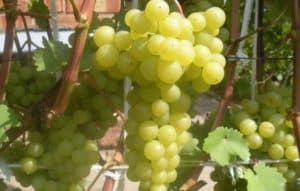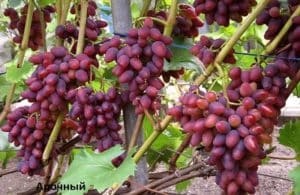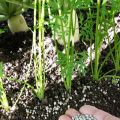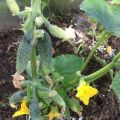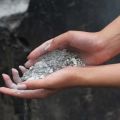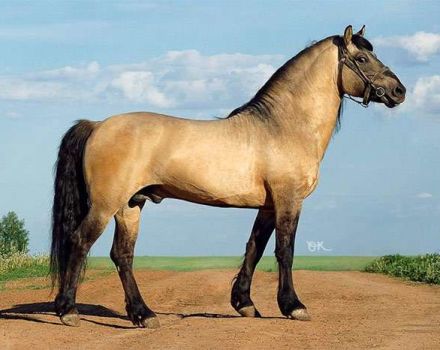How and according to what scheme to feed the grapes in July during the pouring of berries and after flowering for growth
The soil under the grapes is fertilized every three years. Additionally, throughout the entire growth and fruiting, grape bushes require a complex of mineral and organic mixtures. Top dressing delivers nutrients to plants when they are needed. The material will consider what is better to feed the grapes in July, what types of fertilizers are available.
The benefits of fertilization in grape growing
The culture takes nutrients from the soil. But often she lacks this amount. The lack of nutrients must be supplemented with dressings. In July, at the height of fruiting, it is simply irreplaceable. Useful substances enhance the growth of the culture. The berries become large, juicy and sweet. Grapes develop high immunity, thanks to which diseases and pests are not afraid. Gardeners, in order to get the best harvest, are advised to make the mixture in the summer season in July. With the introduction of fertilizers, an increase in yield and soil fertility is expected. What grapes need, we will consider below.
What are the types of fertilizers
The compositions are divided into 2 types:
- organic;
- mineral.
Mineral - inorganic balanced compositions with a high concentration of substances necessary for culture in the form of mineral salts. They give the bushes elements that are important for growth and fruiting. But you cannot overdo it with the quantity, otherwise the soil balance of substances will be destroyed.Organic compounds - peat, manure, dung. They are healthier because they increase soil fertility.
The better to feed grapes in July
If the culture is located on an area with depleted, poor land, then young bushes, on a par with adults, need substances and elements useful for development.

Potassium, phosphorus increase the sugar content of berries, accelerate their ripening. In the first 3 weeks, they are fed with potassium-phosphorus compositions in combination with trace elements - boron, cobalt, manganese, sulfur. Substances increase the amount of sugar in berries, increase the absorption of phosphates, promote the growth of ovaries, and have a beneficial effect on the yield of grape bushes.
In summer, several options are used as top dressing:
- Prepare a solution - mix 10 liters of water, 10 grams of Kalimagnesia, 20 grams of ammonium nitrate. Then the bushes are watered.
- They are fed with an infusion of wood ash.
- A week before the berries ripen, a mixture is introduced: 10 liters of warm water, 20 grams of potassium composition, 20 grams of superphosphate. After complete dissolution of substances, fertilize by root method.
- As a foliar feeding, take 100 grams of superphosphate, 50 grams of potassium sulfate, 10 liters of warm water. The process is carried out until the ovaries appear.

Important: to achieve the maximum effect during the ripening period, root and foliar feeding is carried out.
Complex and compound fertilizers
Boric acid treatment is essential for grapes. The deficiency is reflected in the leaves - white spots appear between the veins. This feeding is especially important in the first year of planting a crop. The bushes are treated with a solution of acid with zinc salt. Proportions: 5 grams of boron and salt, 10 liters of water. This method helps the plant to develop and grow properly.
Fertilization with potassium monophosphate has a positive effect on the sugar content of fruits. It is a concentrated formulation of potassium and phosphorus.
Any soil is fed with superphosphate. It contains phosphorus, sulfur, magnesium. The substance enhances resistance to fungi, frost, increases productivity. How to prepare a solution - dissolve 100 grams of superphosphate in 10 liters of water.
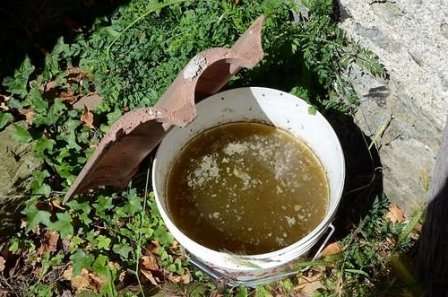
Grapes are treated with humate in order to improve the quality of berries, strengthen the roots, and increase resistance to frost. Complex and complex fertilizers help grape fruits to grow healthy, juicy and sweet.
Organic fertilizers
There are three varieties: potash, phosphorus, nitrogen. Nitrogen is:
- Ammonium nitrate quickly absorbs water and acidifies the soil. It needs to be neutralized with slaked lime. Granules are a convenient form.
- Ammonium sulfate manifests itself better on neutral ground than on acidic ground, since it has increased acidity. Liming will help reduce it.
- Ammonium chloride contains 25% nitrogen. Used on calcareous soils or in combination with alkaline phosphorus compounds.
- Urea is one of the safest types of fertilizers. It dissolves well in water. In the form of crystals, it cakes poorly and dissipates if stored for a long time. Urea in granules cakes well. To reduce acidity, 800 grams of honey is added to 1 kilogram of the substance.

Potash fertilizers for grapes include:
- Potassium chloride - used on all soils. Combines with any kind of fertilizer, except for urea. Acidic earths are lime or lime in advance.
- Sylvinite contains 18% potassium oxide.
- Potassium monophosphate contains potassium and phosphorus. It dissolves perfectly in water.
- Kalimagnesia. In it, potassium and magnesium are in equal proportions.
The phosphorus composition includes:
- Superphosphate in powder form is used almost everywhere. An exception is acidic soils, where it is pre-mixed with humus, chalk. The composition contains gypsum. It is indicated for most plants.
- Double superphosphate - no gypsum.
- Phosphorite flour is added in a larger volume than superphosphate. Shows excellent results only on acidic ground.

Microfertilizers
Trace elements are required for plants in a much smaller volume than potassium, phosphorus and nitrogen compositions. But without them, they cannot develop normally. The most important trace elements are zinc, manganese, boron, iodine, magnesium, sulfur. All substances are contained in many preparations that are produced for feeding bushes and trees.
Kalimagnesia contains 28% potassium and 18% magnesium. One tablespoon dissolves in a bucket of water. Copper sulfate is sprayed on the leaves every 3-5 years at the rate of 1 gram per bush.
Zinc sulfate is effective for alkaline soils. 5 grams of the substance is dissolved in a bucket of water.
Sustained-release capsules are easy to use. Capsules with mineral fertilizers contain micronutrients, macronutrients in equal amounts. The granule is placed in the ground. Then moisture penetrates into it and begins to slowly draw out micronutrient fertilizers. The action is extended in time - from 3 months to 3 years.
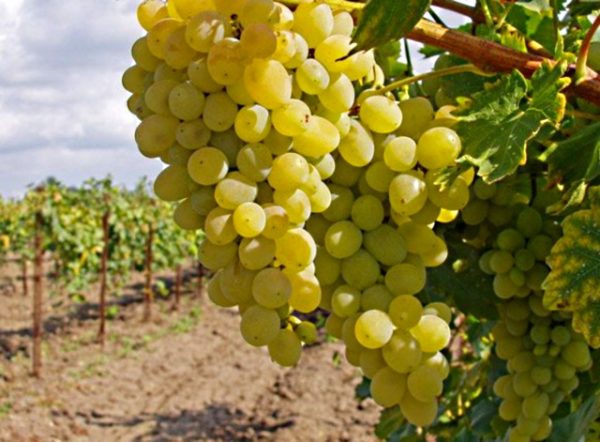
Folk remedies
It is necessary to feed grapes with ash, since it has a beneficial effect on acidic soils. The fertilizer contains potassium, phosphorus, trace elements. Ash is used in combination with superphosphate. Bushes consume a lot of potassium. Baked or fire ash is its source. It is poured over the soil around the plants and the leaves are treated with an infusion of ash.
Also, the soil is fertilized with yeast, which regulates the microflora of the soil. The best are bakeries. Step-by-step steps for preparing top dressing:
- Dissolve 100 grams of live yeast in one bucket of warm water, leave for 12 hours.
- The nutrient solution is poured under the root in a volume of 2 liters.
Chicken manure is a fast-acting, powerful fertilizer. It contains a lot of magnesium oxide, sulfur, which are so essential for grapes.
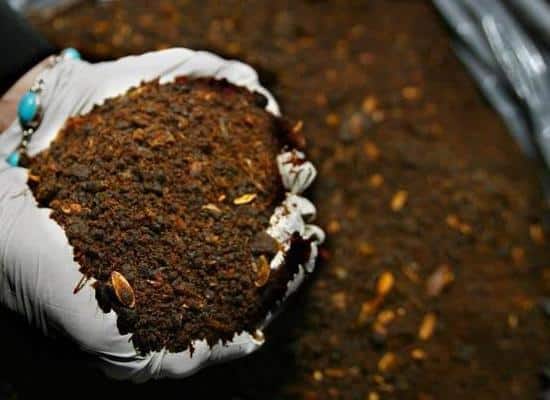
Boron prevents ovaries from falling off, increases the amount of sugar in berries, and immunity to adverse climatic conditions.
Feeding with urea carried out both root and foliar method. If handled correctly and proportioned, the risk of scalding the plant is minimized. It contains 46% nitrogen in the form of amide, water, biuret. Fertilizing with humus is the most common way to feed plants. Organic matter is used in its pure form or compost is made from it. It helps to restore the balance of the ground, its structure.
Fertilization calendar
The compositions, as a top dressing, are used for the entire period of fruiting and crop growth. Consider the scheme for introducing mixtures:
- Pre-planting compounds are applied in large quantities into the hole in preparation for planting a bush. They play an important role - they supply the plant with food for several years.
- The main feeding is carried out in autumn or early spring. Next to the plants, a hole is dug to a depth of half a meter and the mixture is laid in it.
- In autumn, organic matter is sometimes used - manure, peat. Ash and superphosphate are added to them. In the spring, fertilize with different compounds, including nitrogen.
- Additional feeding is carried out at different times in the summer. Fertilizers are applied in the form of solutions to the recesses near the bushes. Foliar top dressing is also carried out - the leaves of the bushes are sprayed. Gardeners also use green dressing - oats and peas are planted next to the crop.
Southern culture needs regular feeding. Some organic fertilizers little help. It is additionally fed for a better harvest. You need to add substances wisely and competently. If you follow all the rules, rules, tasty, juicy, sugar berries will grow on the vine.
